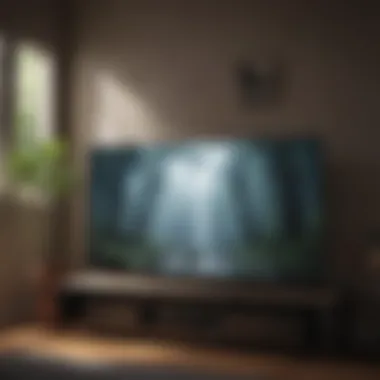Choosing the Best Screen Cleaner for LED TVs


Intro
Selecting the right screen cleaner for LED TVs is more significant than one might initially think. The clarity and longevity of a screen can be significantly affected by the cleaning products one uses. Many consumers overlook the necessity of paying attention to the chemical compositions of these cleaners, as well as their impact on delicate screens. This guide delves into the various factors one should consider when opting for a screen cleaner, including materials, types, and common pitfalls.
In this article, we will explore different categories of screen cleaners, assessing their effectiveness and safety. Additionally, we will examine how improper cleaning routines can lead to screen damage, reducing the lifespan of your investment. We aim to equip readers with essential knowledge to maintain their screens effectively, ensuring optimal viewing clarity and screen protection.
This comprehensive guide will highlight:
- The importance of selecting a screen-friendly cleaner.
- Various types of screen cleaners available.
- Common mistakes in screen maintenance.
- Innovative techniques to achieve better results.
With this information, you can make an informed decision that protects your LED television while enhancing your viewing experience.
Understanding LED TVs
Understanding LED TVs is crucial when it comes to selecting the appropriate screen cleaner. LED TVs, or Light Emitting Diode televisions, have become ubiquitous in modern viewing experiences. Their sleek design and ability to produce vibrant colors enhance our entertainment. However, the technology behind these screens also requires special care in maintaining their clarity and longevity.
Firstly, it is important to recognize that LED stands for a specific type of backlighting technology. This distinction plays a large role in its sensitivity to various cleaning agents. Regular maintenance can significantly improve the lifespan of your television. Knowing the basics about LEDs allows for informed decisions about cleaning products that can effectively eliminate dust and fingerprints without causing damage.
Basics of LED Technology
LED displays utilize a series of diodes to emit light, serving as a backlight for the screen. This technology provides better brightness and color accuracy compared to traditional LCD screens. These displays are thinner and more energy-efficient, making them a popular choice for consumers.
The composition of an LED screen includes a layer of liquid crystal display (LCD) panels. The LED lights help illuminate these panels, producing a clear image. This layered structure is delicate, and using inappropriate cleaners can harm both the screen and the overall display performance.
Differences Between LED and Other Screen Types
The distinction between LED TVs and other technologies, such as Plasma or OLED, is crucial when selecting cleaning products. Plasma screens are composed of gas-filled cells that can be damaged easily. OLEDs, which stand for Organic Light Emitting Diodes, have their own set of vulnerabilities.
LED screens are often more durable than Plasma screens, but they can still suffer from scratches or screen burn if not properly cared for. Additionally, the materials utilized in manufacturing these screens may not react favorably to certain chemicals found in generic cleaning supplies.
Understanding these differences informs consumers about the best practices to maintain their screens.
"Regular cleaning enhances both the performance and durability of LED TVs. Choosing the right cleaner is paramount."
In summary, a deep understanding of LED technology is essential for selecting the best screen cleaner. Recognizing how these screens function and their vulnerabilities can guide users to make informed choices, ensuring their investment remains in good condition.
Importance of Screen Maintenance
Maintaining your LED TV screen is not just a matter of aesthetic appeal but also impacts the longevity and functionality of the device. Regular screen maintenance ensures that the clarity of the picture is preserved, providing you with the best viewing experience. Over time, dust, fingerprints, and smudges accumulate on the screen, obstructing light and reducing quality. Therefore, a clean screen allows for the full vibrancy of colors and the crispness of details.
Beyond visual impact, proper screen maintenance also protects the investment you have made in your television. Many consumers overlook how debris and grime can contribute to the degradation of the screen surface. For LED screens, using inappropriate cleaners or neglecting to clean regularly can lead to a myriad of problems.
Such aspects add significant weight to the importance of screen maintenance.
Why Regular Cleaning Matters
Regular cleaning contributes substantially to optimal viewing conditions. When dust settles on the screen, it absorbs light, creating an overall dullness in the image quality. By establishing a cleaning routine, you can ensure that the screen remains bright and clear. Routine cleaning does not have to be labor-intensive or time-consuming. Even a quick wipe down every couple of weeks can make an immense difference.
Moreover, a clean screen leads to a more pleasant viewing experience for all users. Imagine having guests over for movie night, and the display is marred by unsightly streaks and spots. This can make it less enjoyable and might even detract from engaging discussions. Ultimately, the act of cleaning is about ensuring that the experience is not compromised and that you, as a viewer, can appreciate the content without distractions.
Potential Damage from Improper Cleaning
Improper cleaning can lead to severe and irreparable damage to your LED screen. Many consumers tend to use common household cleaners or abrasive materials when tackling screen maintenance. This is a grave mistake. If you use products such as glass cleaners or paper towels, you run the risk of stripping away protective coatings from the screen, leading to scratches or cloudiness over time.
It’s worth noting that the screen could begin to show bright spots or discolored areas due to over-scrubbing or the use of harsh chemicals. Such damage may eventually lead to functionality issues, requiring costly repairs or replacement.
"An ounce of prevention is worth a pound of cure." This applies here; ensuring the proper procedures are followed can save you from future headaches.


To avoid these pitfalls, it is essential to familiarize yourself with the manufacturer’s guidelines for your specific TV model. These recommendations often include suggestions for cleaning solutions and materials safe for use on screens. Keeping to these guidelines can help maintain your screen in excellent condition, prolonging its lifespan and preserving the quality you paid for.
Criteria for Choosing the Best Screen Cleaner
Selecting an appropriate screen cleaner for LED TVs is not merely a matter of personal preference. The right cleaner can significantly influence both the functionality and longevity of your device. The various screen types and the materials used in their construction necessitate a careful examination of their compatibility with cleaning agents. Furthermore, understanding the specific criteria that govern the selection of these cleaners can enhance the overall viewing experience, keeping your screen free from dirt, dust, and smudges.
Chemical Composition Considerations
When assessing screen cleaners, one of the foremost criteria to consider is the chemical composition of the product. Not every cleaner is suitable for LED screens; some may contain harsh solvents that could degrade the screen's surface. For example, cleaners that possess ammonia or alcohol can lead to long-term damage, including discoloration and reduced clarity.
An ideal screen cleaner should feature a mixture of gentle surfactants that effectively remove grime but do not compromise the screen's integrity. Many products utilize plant-based or biodegradable ingredients, which tend to be less harmful while still providing effective cleaning capabilities. Always check the label for specific terms such as "non-toxic" or "safe for screens." This level of vigilance will help you protect the investment in your television.
Compatibility with Screen Type
It is crucial to ensure that any selected cleaner is compatible with your specific screen type. LED screens can vary in sensitivity and coating materials, so using a cleaner meant for a different display type, such as LCD or plasma, could cause damage. For example, a cleaner designed for LED televisions often will not work for an OLED screen.
Taking this into account can save time and reduce costs associated with repairs. Always refer to the manufacturer’s manual for their recommendations on cleaning products. Some brands even produce their own line of cleaning solutions, specifically formulated for their screens. Using a compatible cleaner not only prevents damage but also helps maintain the original clarity and color fidelity of the display.
Safety for Users and Environment
Choosing a screen cleaner must also involve a consideration of safety—for users and the environment. Many commercial cleaning products can release volatile organic compounds (VOCs), which are harmful when inhaled. When selecting a cleaner, look for options labeled as eco-friendly or low-VOC. These products minimize health risks without compromising performance.
Additionally, the environmental impact of the cleaning product should not be overlooked. Opting for biodegradable cleaners reduces the ecological footprint and supports sustainable practices. This conscious choice benefits both personal health and the environment, equipping users with a cleaner that works well and is responsible.
"Investing time in understanding the right criteria for selecting a screen cleaner pays off in the long run, protecting both your viewing experience and health."
With these criteria in mind, selecting the optimal screen cleaner becomes a more structured process. This diligence not only preserves the functionality of the LED television but also enhances the viewers' satisfaction by ensuring a consistent, clear display.
Types of Screen Cleaners Available
Selecting the right screen cleaner for LED TVs involves understanding the various options available in the market. The different types of screen cleaners have specific benefits and considerations that can affect not only the effectiveness of cleaning but also the longevity of the screen itself. Understanding the categories of cleaners helps in making an informed choice that aligns with your cleaning needs and habits, promoting optimal viewing conditions while safeguarding your investment.
Liquid Cleaners
Liquid screen cleaners are a popular choice due to their versatility and effectiveness. Most liquid formulations often contain a blend of surfactants and solvents designed to break down fingerprints, dust, and smudges without damaging the delicate screen. When selecting a liquid cleaner, consider those labeled as ammonia-free, as ammonia can be harsh on LED screens.
- Benefits of Liquid Cleaners:
- Considerations:
- Provide thorough cleaning capabilities.
- Can be used with various types of cleaning cloths.
- Usually effective on stubborn stains.
- Requires a separate cloth for application.
- Must follow proper methods to avoid streaks or residue.
It is crucial to read the instructions for use carefully. Using too much product or failing to buff the surface can lead to unsightly streaks.
Wipes and Cloths
Wipes and cloths offer convenience for people who prefer an all-in-one cleaning solution. Pre-moistened wipes contain the appropriate cleaning solution in a disposable format. This can be a time-saver, ideal for quick touch-ups before a movie or showcase. Cloths, on the other hand, can be reusable and often made of microfiber material, which is safe for screens.
- Benefits of Wipes and Cloths:
- Considerations:
- Easy to use and portable.
- Minimizes the risk of over-applying cleaner.
- Ideal for quick cleaning tasks.
- Some wipes may not be suitable for all screen types.
- Potential environmental concerns with disposable products.
Always check the packaging to ensure compatibility with LED screens. Avoid wipes with added fragrances or harsh chemicals, as they may leave residues or harm the screen.


Duster Tools
Duster tools are typically used for a preliminary clean or when dealing with fine dust particles. These tools come in various designs, from handheld to electric options, and are excellent for reaching crevices and delicate areas that might be challenging to clean with liquid solutions. They usually do not involve any liquid, hence reducing the risk of damage.
- Benefits of Duster Tools:
- Considerations:
- Great for removing loose dust without risk of scratches.
- Often lightweight and easy to store.
- Can be used frequently without the need for liquid.
- Not effective for sticky residues or fingerprints.
- May require follow-up cleaning with liquid solutions for thoroughness.
A good practice is to incorporate duster tools into a regular maintenance routine, ensuring the screen remains dust-free and ready for optimal viewing.
Top Recommended Screen Cleaners
Selecting the right screen cleaner for your LED TV is vital for maintaining the quality and longevity of your display. Various screen cleaners are available in the market, but not all are created equal. Choosing the suitable cleaner can prevent damage and ensure that your screen remains bright and clear. This section will explore notable products, highlighting essential features, user experiences, and expert opinions. By focusing on top recommended screen cleaners, readers can make informed decisions for optimal screen care.
Product Reviews and Features
In this segment, we take a closer look at some of the most recommended screen cleaners and their unique attributes. Here are a few examples:
- Screen Gleam: This liquid cleaner is known for its effectiveness in removing dust and fingerprints without streaking. It comes in an easy-to-use spray bottle and contains safe ingredients that won’t compromise screen coatings. Users particularly appreciate its non-toxic formula, which is a bonus for households with pets and children.
- MagicFiber Microfiber Cloths: While not a liquid cleaner, these cloths deserve mention for their ability to clean screens without any chemicals. They are lint-free and reusable, making them an eco-friendly option. Users consistently highlight their durability and effectiveness in cleaning without scratching.
- zeiss Screen Wipes: Zeiss offers individually packaged wipes that are practical for on-the-go cleaning. These wipes are moistened with a mild cleaning solution that effectively removes smudges and dirt. Many users rate these wipes highly for their convenience, especially for travel or quick cleanups.
Each of these products showcases unique traits, catering to different user needs. Understanding the features allows consumers to select a cleaner that suits their lifestyle and cleaning habits.
User Feedback and Ratings
User reviews are an essential aspect of understanding real-life performance and satisfaction with screen cleaners. Here are some insights from feedback and ratings:
- Effectiveness: Many users across platforms like Reddit and Facebook praise products like Screen Gleam for swiftly dealing with stubborn fingerprints and dust. Ratings often highlight how quickly the cleaner works, with most users achieving satisfactory results in less than a minute.
- Safety and Eco-friendliness: Users often commend cleaners that avoid harsh chemicals. Both Screen Gleam and MagicFiber Microfiber Cloths receive high marks for being safe for household use. Feedback frequently mentions the peace of mind in using non-toxic cleaners around children and pets.
- Ease of use: Reviews generally emphasize the convenience of application. Zeiss Screen Wipes have a favorable reputation for being ready to use and portable. Consumers enjoy how easy it is to keep one or two packets handy for immediate cleaning needs.
The feedback obtained from users plays a significant role in guiding potential buyers. Positive reviews and high ratings often translate to trust in the recommended products, leading to better-informed purchasing decisions.
"Choosing the right screen cleaner is not just about cleanliness; it's about preserving the quality of your viewing experience and ensuring your investment in technology lasts longer."
This synthesis of product features and user feedback offers valuable insight into the best screen cleaners for LED TVs. Readers can draw from these recommendations to achieve a clear, vibrant display, further enhancing their viewing experience.
Common Mistakes in Screen Cleaning
Maintaining a clean screen is essential for enjoying the best viewing experience from your LED TV. However, many users make significant mistakes in their cleaning routines that can lead to damage and decreased screen performance. This section will delve into these common pitfalls, allowing you to enhance your understanding and avoid costly errors.
Using Wrong Materials
One of the most prevalent mistakes is the use of incorrect cleaning materials. Some people resort to paper towels, rough cloths, or cleaning solutions meant for non-electronic surfaces. These items can create scratches or leave residues that compromise picture quality.
Instead, it is critical to choose soft, non-abrasive microfiber cloths designed specifically for electronics. Such cloths capture dust effectively without damaging the screen surface.
Additionally, the wrong cleaning solutions can harm the screen. Products that contain ammonia or alcohol are particularly harmful to LED screens. They can strip coatings on the display, leading to issues like glare or reduced color accuracy. Always opt for specially formulated screen cleaners or mild soap mixed with water to ensure safety.
"Using the right materials in screen cleaning is not a matter of preference, but necessity for the longevity of your device."
Neglecting Manufacturer's Instructions
Every LED TV comes with manufacturer-specific instructions regarding screen care. Ignoring these guidelines can lead to unintentional damage. Manufacturers often provide insights on compatible cleaning agents and methods best suited for their models.
For instance, certain cleaning solutions recommended for one brand might not be suitable for another due to different screen coatings. If you are unsure, always refer back to the user manual. It typically covers cleaning techniques, material suggestions, and frequency of cleaning, which are pivotal for maintaining your LED TV's condition.


Falling short of these instructions can void warranties and lead to expensive repairs. Hence, adhering to these guidelines not only safeguards your device but prolongs its lifespan. Understanding and applying these fundamental principles avoids potential hazards and keeps your screen looking vibrant.
Innovative Methods for Screen Cleaning
Innovative methods for screen cleaning can transform the way users maintain their LED TVs. This section will cover distinct approaches that leverage both creativity and technology. By employing these methods, one can enhance the longevity of the screens while achieving superior clarity in viewing experiences. Keeping screens clean is crucial, however, the techniques chosen can significantly influence the results.
Using DIY Solutions Effectively
DIY solutions for cleaning screens can be effective and economical. Homemade cleaning solutions often include simple ingredients like distilled water and white vinegar. This mixture can effectively remove smudges and dust without the risk of harsh chemicals damaging the screen. Some methods also involve using microfiber cloths, which are non-abrasive and safe. To prepare this DIY cleaner:
- Mix equal parts of distilled water and white vinegar in a spray bottle.
- Lightly spray the microfiber cloth, not the screen directly.
- Gently wipe the screen in circular motions.
This method reduces the risk of excess moisture getting into the electronic components of the TV, which can lead to damage. Most importantly, these solutions tend to be more environmentally friendly than commercial alternatives, making it a wise choice for eco-conscious users.
Incorporating Advanced Technology
Advanced technology has introduced many cleaning products that elevate the screen maintenance experience. There are robotic cleaners specifically designed for screens. These devices automatically detect dust and dirt, and clean effectively without any physical labor from the user. Additionally, specialized apps can be paired with these devices to maintain a cleaning schedule.
Moreover, some new products on the market utilize ultrasonic technology. This method can clean screens by generating sound waves that create a fine mist of cleaning solution. This mist is effective for reaching crevices and areas that might be missed with traditional cleaning methods.
In sum, these innovative cleaning methods offer both practicality and efficiency. Incorporating them can provide users with an edge when it comes to maintaining their LED TVs, ensuring they not only look good but also function well. Understanding and utilizing these methods can lead to substantial improvements in how we care for our screens.
Long-Term Care for LED Screens
Long-term care for LED screens is vital for enhancing both their lifespan and performance. Given the investment many make in these devices, neglecting their maintenance can lead to diminished viewing experiences and costly replacements. Understanding how to care for LED screens over time can significantly improve image clarity and prevent damage. Regular upkeep and a thoughtful approach to cleaning routines ensure that the screens remain vibrant and functional for many years.
Regular Cleaning Schedules
Establishing and adhering to regular cleaning schedules is essential. This not only allows for the consistent removal of dust and grime but also prevents the buildup of substances that can damage the screen over time. A cleaning schedule often adapts to the usage of the TV. For example, in a household with children or pets, cleaning may need to be more frequent.
Consider the following recommendations for a cleaning routine:
- Weekly Cleaning: Dust the screen and its surroundings to avoid stationary dust accumulation.
- Bi-Monthly Deep Cleaning: Use appropriate cleaners to remove fingerprints and smudges.
- Seasonal Checks: Inspect the screen for any signs of wear or damage, ensuring your cleaning supplies haven't degraded.
Maintaining a schedule also helps cultivate a mindful approach to screen cleanliness, making it easier to notice when more intensive maintenance is required.
Protective Equipment Recommendations
Protection is as important as cleaning when it comes to caring for LED screens over time. Using certain protective equipment can mitigate risks that may arise from regular usage. Here are some recommendations:
- Screen Protectors: Consider applying a thin, transparent protector to shield against scratches and smudges.
- Microfiber Cloths: Invest in high-quality microfiber cloths designed for electronics. They are effective in cleaning without scratching the surface.
- Dust Covers: During prolonged periods of non-use, utilizing a dust cover can prevent particles from settling on the screen.
By using these protective resources, the risk of damage is reduced, ensuring that your LED screen remains in optimal condition.
"Preventive care is essential for ensuring the longevity of your LED screen. Regular maintenance coupled with protective elements can make a significant difference."
Culmination
In this guide, we explored the vital aspects of selecting a screen cleaner for LED TVs. Understanding the significance of maintaining these screens cannot be overstated. Regular cleaning enhances viewing quality, prolongs the lifespan of the screen, and ensures that your investment remains protected. As LED technology becomes increasingly prevalent in our lives, being informed about the cleaning process is vital.
Recapping Key Points
- Understanding the Importance: Regular maintenance helps to remove dust and smudges that can distort the picture quality. This allows for a clearer and more enjoyable viewing experience.
- Choosing the Right Cleaner: Factors such as chemical composition and compatibility with the screen type should guide your choice. This ensures that you do not inadvertently cause damage.
- Recognizing Common Mistakes: Avoid using improper materials or neglecting the manufacturer's instructions. Being aware of these pitfalls can save you from unnecessary damage.
- Long-Term Care Strategies: Adopting a regular cleaning schedule and utilizing protective equipment can significantly bolster the condition of your screen.
Final Thoughts on Screen Care
Maintaining LED screens goes beyond mere aesthetics. It is about preserving functionality and longevity. The right cleaning products play a crucial role. An investment in quality cleaners can yield substantial benefits for your viewing experience. Moreover, it is recommended to keep abreast of new products and innovations in screen care, as the market evolves constantly. By being proactive and informed, you can ensure that your screen remains in top condition and serves you well for years to come.
"Screen maintenance is not just an aesthetic choice. It’s a practical necessity for longevity and clarity."
Taking the time to consider the elements discussed ensures that you choose wisely and care for your screens effectively.















